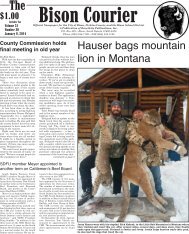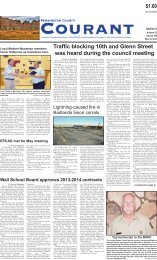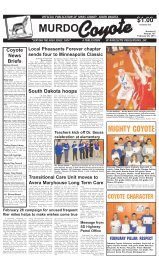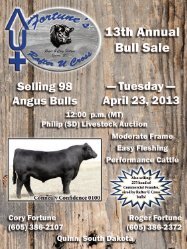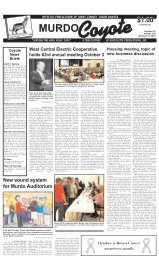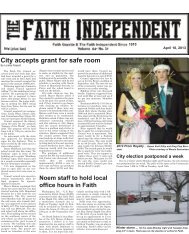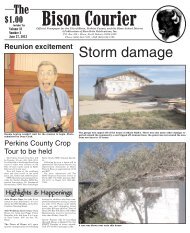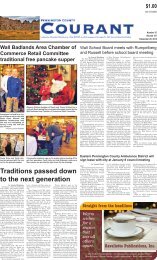E-Press 8-30-12_Layout 1.pdf - Pioneer Review
E-Press 8-30-12_Layout 1.pdf - Pioneer Review
E-Press 8-30-12_Layout 1.pdf - Pioneer Review
Create successful ePaper yourself
Turn your PDF publications into a flip-book with our unique Google optimized e-Paper software.
Agriculture … August <strong>30</strong>, 20<strong>12</strong> • Kadoka <strong>Press</strong> • Page 8<br />
Watch for weeds in imported hay<br />
SDSU Extension<br />
offers nitrate testing<br />
across the state<br />
Due to the drought, nitrate toxicity<br />
is an issue this growing season.<br />
Before cutting silage or feeding forages<br />
to livestock, test for nitrates.<br />
SDSU Extension offers a nitrate<br />
quick test for standing forage. Interested<br />
parties can take forage<br />
samples to the following Extension<br />
Regional Centers; Lemmon,<br />
605.374.4177, Rapid City,<br />
605.394.1722, and Winner,<br />
605.842.<strong>12</strong>67; and the following<br />
county offices; Charles Mix County<br />
Office, Clark County Office, Douglas<br />
County Office, Hamlin County<br />
Office, or Pennington County Office.<br />
Please call before you take<br />
samples to be tested to ensure that<br />
the individual who is trained to do<br />
the testing is available.<br />
Nitrate quick test is an indicator<br />
of presence or absence of nitrate in<br />
forages. If present, producers can<br />
send the sample in for a quantitative<br />
analysis or wait for plants to<br />
continue to mature/grow.<br />
Trained personnel are only allowed<br />
to do the testing. If you have<br />
any questions on nitrate testing,<br />
contact your local SDSU Extension<br />
Regional Center. For information<br />
on how to evaluate nitrate tests or<br />
other drought resources, visit<br />
iGrow.org/drought.<br />
To Report<br />
A Fire<br />
Call:<br />
Kadoka . . . .837-2228<br />
Belvidere . .344-2500<br />
Interior . . . . . . . . .911<br />
Long Valley . . . . .911<br />
Green Valley . . . .911<br />
Shortages in pasture availability<br />
have forced many to purchase hay<br />
this year, sometimes from other<br />
states or lower quality hay. When<br />
doing this, it is important to be<br />
aware of potential unintended consequences,<br />
such as introductions of<br />
new noxious/invasive weeds, potentially<br />
toxic weeds in the hay, and<br />
hay containing herbicide residues<br />
that could injure broadleaf crops in<br />
future years, says Mike Moechnig,<br />
SDSU Extension Weeds Specialist<br />
and Roger Gates, SDSU Rangeland<br />
Extension Specialist.<br />
"It is illegal to transport hay<br />
containing noxious weed seeds in<br />
South Dakota regardless if the hay<br />
is from this or another state,"<br />
Moechnig said. "In fact, this is a<br />
Class 2 misdemeanor that could be<br />
punishable by <strong>30</strong> days in prison<br />
and/or a $500 fine."<br />
Gates adds that this law applies<br />
to situations in which the violation<br />
constitutes a "substantial" risk of<br />
contaminating fields or other land.<br />
"Avoiding known weed patches<br />
at harvest will reduce contamination.<br />
Hauling bales that are net<br />
wrapped or tarping the load will<br />
minimize the risk of excessive weed<br />
seed distribution," Gates said.<br />
The specialists say perhaps the<br />
primary motivation to avoid weedy<br />
hay is to avoid future weed infestation<br />
problems on your property.<br />
"Fortunately, weed infestations<br />
generally do not explode in a single<br />
season so watching for noxious or<br />
invasive species next year should<br />
enable effective control of new infestations<br />
before they become a<br />
costly problem," Moechnig said.<br />
"Leafy spurge, Canada thistle, and<br />
yellow toadflax are likely some of<br />
the most difficult weeds to control<br />
that may be present in grass hay so<br />
it is particularly important to be<br />
watching for these weed species<br />
next year."<br />
Moechnig says the need to hay<br />
areas normally not harvested could<br />
also increase the risk of having<br />
toxic weeds in the hay.<br />
"Perhaps the most toxic weeds<br />
are poison hemlock and waterhemlock,"<br />
Moechnig said. "Lethal doses<br />
for some livestock species may be<br />
only 0.2 - 0.8 percent of their body<br />
weight."<br />
He adds that poison hemlock<br />
populations seemed to expand over<br />
the past couple years, particularly<br />
in northeastern South Dakota,<br />
which may be partially due to<br />
greater precipitation rates.<br />
"Hemlock species are in the carrot<br />
plant family, so flower clusters<br />
resembling carrot flowers may be<br />
visible in hay," Moechnig said.<br />
"Whorled milkweed is another<br />
weed of concern, but populations<br />
are often not very dense, particularly<br />
in areas with taller grass that<br />
may be hayed. Common weed<br />
species, such as kochia, lambsquarters,<br />
pigweeds, thistles, and others<br />
can also increase hay nitrate concentrations<br />
if present in large<br />
quantities."<br />
In addition to unknown weed<br />
seeds and plants in the hay, Gates<br />
says unknown herbicide residues<br />
could also cause problems.<br />
"Grass treated with herbicides<br />
such as picloram (Tordon, Grazon),<br />
aminopyralid (Milestone/Fore-<br />
Front), or clopyralid (Curtail,<br />
Stinger) could still contain residues<br />
of these herbicides that will quickly<br />
pass through livestock and can remain<br />
in their manure," Gates said.<br />
"Spreading this manure or feeding<br />
bales on fields that may be planted<br />
to broadleaf crops next year could<br />
result in severe crop injury. These<br />
residues could persist in the soil for<br />
2 - 3 years. Therefore, it is important<br />
to keep manure in pastures if<br />
it is not known exactly what herbicides<br />
were applied to the hayfield."<br />
Pictures of noxious weeds and<br />
control recommendations may be<br />
found on iGrow.org and on iPhone<br />
and Android cell phones apps provided<br />
by SDSU. Infestation risk<br />
may also be minimized by careful<br />
management of hay feeding areas.<br />
Drought conditions reduce the<br />
vigor of pasture vegetation increasing<br />
bare ground and enhancing<br />
successful weed germination and<br />
establishment. Feeding imported<br />
hay in a restricted area or even in<br />
corrals may contain the area that<br />
needs to be carefully monitored the<br />
following spring.<br />
Concerns of weeds and herbicide<br />
residues do not have to be limiting<br />
factors when purchasing hay. Properly<br />
responding to risks of new<br />
weed infestations or contaminated<br />
manure can enable people to avoid<br />
greater and more costly problems<br />
in the future. To learn more visit<br />
iGrow.org.<br />
!2%1/+0) #55.' #.'4<br />
<br />
///( !$!($!.+,'#'%<br />
%!$ !&'( !$!($!.+,'#'%<br />
: !" !! <br />
$+) 360 1( #.. %.#44'4 1( %#55.' (13 163 42'%+#. 4#.' $+) %318& 1(<br />
$69'34 10 # 7'39 *15 	 .15 1( %1/2'5+5+10 10 5*' 9'#3.+0)4 #0&<br />
451%- %184<br />
% ''<br />
", %! ##<br />
%&$% <br />
%&$% <br />
) %&$% <br />
"#! $% <br />
%!"! %" "! ),<br />
) %&$% <br />
) %&$% <br />
) %&$% <br />
&"%', +! "!& !<br />
$ "#! $% <br />
$ $% <br />
%"&' '' " #!, ##<br />
$ %&$% <br />
$ %&$% <br />
!%& )&'" " "' &#%!&<br />
) %&$% <br />
) %&$% <br />
) %&$% <br />
) %&$% <br />
& %!& ##<br />
%&$% <br />
%% &'& )<br />
%&$% <br />
%&$% <br />
%&$% <br />
%&$% <br />
%&$% <br />
"! %-, % !*<br />
"#! $% <br />
%# % %! #('<br />
$ "#! $% <br />
(!' (#%<br />
$ %&$% <br />
$ $ $% <br />
!!, " %!&"! (!"! !'%<br />
"#! $% <br />
&('& %! "*&<br />
"#! $% <br />
"#! $% <br />
"#! $% <br />
"&"! )&'" & % !<br />
) "#! $% <br />
$ "#! $% <br />
&%, ##<br />
%&$% <br />
% &%% *<br />
"#! $% <br />
'(&, &#' $'$ && %<br />
& ' )'#% $<br />
&& # &<br />
%, "!&! !'&<br />
% ''<br />
!%, %( B * ")%<br />
$ ( "$ +%<br />
" " <br />
<br />
'(&, &#' %# $ && % $'$<br />
&& %<br />
'(&, &#' %# %&" ") $ $ % <br />
$'$ && %<br />
!$!( !.+,'# -,!'& !& '&"-&,!'& /!,<br />
-(*!'* !.+,'# -,!'& /!$$ '*!&<br />
.!' +$ + & !,!'&$ +*.! ,' '-* '&+!&'*+<br />
/!, )-+,!'&+ '-, , .!' ($+ $$<br />
**0 '+, , <br />
'" "!&! '' "% ) %#%&!'') "" ' ,"(% '' ) (& <br />
'"% %"&' "A92<<br />
<br />
, %* 52718.9<br />
1.2-3. : <br />
"! 52718.9?0>5:922<<br />
$/. "92 : <br />
/22 <br />
,!! *&% ?0>5:922<<br />
$/8- : <br />
<br />
<br />
"#! $% <br />
"! &!%(! "<br />
%&$% <br />
%%, ! '&!<br />
"#! $% <br />
! %" ! *' %)%<br />
"#! $% <br />
&'!, '' #"% *!<br />
"#! $% <br />
% &'! !* (!%*""<br />
"#! $% <br />
#%&"! "+ %<br />
"#! %#+ $% <br />
% (' %*, ##<br />
"#! $% <br />
"! (&'! "! (!"! !'%<br />
"#! %#+ $% <br />
%%, &"' &!%(! *<br />
"#! $% <br />
' '(% !"! & ' $(!!<br />
$ "#! $% <br />
&" %"'%& ##<br />
$ "#! $% <br />
%"&& * & ##<br />
$ "#! $% <br />
" & %'"!<br />
$ "#! $% <br />
", #"% *!<br />
"#! $% <br />
(!! %! *&'<br />
"#! $% <br />
' & '' " %# ',<br />
$ "#! $% <br />
"! #'%& (%"<br />
"#! $% <br />
*% %! "<br />
"#! $% <br />
"*! %(&"! "! ),<br />
) %&$% <br />
$% <br />
%&' , % %! *<br />
%&$% <br />
$% <br />
%!' &%% *<br />
"#! $% <br />
%" "!' &'(%&<br />
%&$% <br />
$% <br />
& "!&'"! &#%!&<br />
$ %&$% <br />
%&$% <br />
) %#+ $% <br />
%"+, %%&"! "! ),<br />
$ %&$% <br />
'(&, &#' %# $ && $% <br />
% $'$ && %<br />
'(&, "' %# $% % $'$<br />
&& %<br />
'(&, "' %# $% %<br />
*!&, "' %# %&" ") $ $ % <br />
)'# ") ' $& %<br />
'(&, "' %# $% %<br />
*!&, "' )'# ") ' $& %<br />
'(&, "' %# $% %<br />
*!&, "' )'# ") ' $& %<br />
'(&, "' %# $% %<br />
*!&, "' )'# ") ' $& %<br />
&'(%, !") %# %&" ") ! $ $ % <br />
)'# ") ' $& %<br />
'(&, !") %# $% % $'$<br />
&& %<br />
*!&, !") )'# ") ' $& %<br />
'(&, !") %# $% % $'$<br />
&& %<br />
'(&, !") %# %&" ") $ $ % <br />
$'$ && %<br />
''2 4622135+0) ! ! +4<br />
163 71+%' +0 )17'<strong>30</strong>/'05 51 3'23'4'05 !<br />
%#55.' 231&6%'34 +0 53#&' /#3-'5+0) +446'4<br />
,1+0 51	 *'.2 /#-' # &+(('3'0%'<br />
! #%"(' ?0>5:922<<br />
<strong>12</strong>/58<strong>12</strong>2/ : <br />
&')! &'*%'<br />
,.



